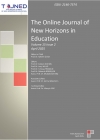TOJNED - Volume 3 - Issue 2 - April 2013
 A Comparative Review on Chinese Vocational Education and Training System
A Comparative Review on Chinese Vocational Education and Training System Xi Yu
Abstract: This study described China s vocational education and training (VET) system, and analyzed various challenges that the system is in face with. It demonstrated the reforms that are undertaken including policy transfer and borrowing attempts from the German Dual System, Singaporean vocational model, and the U.S. Career and Technical Education (CTE) system. Due to China s unique geographical, cultural, political and economic conditions, it is not feasible to transform Chinese vocational system through adopting models from other countries. However, elements of the foreign models can be adopted for future reforms on China s VET system. Also, efforts and support from governmental policy-making and academic research are needed. In addition, transnational and global cooperation with vocational institutions from overseas needs to be continued in the future under the trend of globalization in order to collaboratively overcome barriers and increase high-skilled workforce in global labor market.
 Reflection Levels of Values to Be Gained Explicitly in Secondary Schools on Textbooks
Reflection Levels of Values to Be Gained Explicitly in Secondary Schools on Textbooks Tekin ├āŌĆĪelikkaya, U├ä┼Ėur Ba├ģ┼Ėarmak, Simge Filo├ä┼Ėlu, Bilge ├ģ┼Šahin
Abstract: Which values take place, how much space the values cover, which ones are emphasised more frequently are of capital importance in Social Studies textbooks. This study which was conducted to determine the place of values in secondary school social studies textbooks was carried out by document analysis, one of the qualitative research techniques. The latest publications of secondary school social studies guide books for teachers belonging to both Meb and private publishing houses were analysed in the research The data collected from the books were analysed under 7 themes and 26 sub-themes and the findings belonging to the themes were presented in the tables and finally the sub-themes belonging to these themes were given as an explanation under the tables. While values of responsibility, cooperation, aesthetic, being scientific, sensitivity to cultural heritage, respect to rights and freedoms are included adequately, it can be stated that values of helping each other, hardworking, and sensitivity to natural environment, patriotism, honesty, being fair, respect to flag and the Turkish National Anthem, and peace are not included sufficiently. In terms of publishing houses, it can be stated that Meb publications are more efficient with regards to including knowledge related to values and values education in every class level and teaching values.
 Storybook Reading in the Arab World
Storybook Reading in the Arab World Nisreen Anati
Abstract: Storybook reading at the kindergarten level is not given adequate attention by Arab parents and caregivers due to the perspective that children do not understand formal Arabic/FusHa and those children do not enjoy being read to from books. However, a body of research supports the hypothesis that storybook reading has a positive impact on children├óŌé¼Ōäós literacy development and reading interest. In support with the research findings, the results drawn from the current study which targeted Arab kindergartners indicated that exposing children to storybook reading appears to support early literacy for Arab kindergartners. There was a noticeable increase in the proportion of formal Arabic vocabulary and clauses in the kids├óŌé¼Ōäó utterances. Kindergartners have showed a positive progress on measures of comprehension and richly use of vocabulary and complex sentences in telling picture stories. Besides using words in FusHa, the children├óŌé¼Ōäós speech has tended to become more distinct and more grammatical. They will pronounce the end of words more clearly and can distinguish between singular and plural forms- both of these attributes of literary Arabic. Most importantly, the children├óŌé¼Ōäós reading motivation was positively influenced.
 Student Level Factors Influencing Performance and Study Progress
Student Level Factors Influencing Performance and Study Progress Liv Susanne Bugge, Gerd Wıkan
Abstract: A large proportion of Norwegian youths are students in higher education. This is in line with Norwegian education policy. However, progress and performance are a problem. This is costly both for the individual and for the institutions. This paper examines which student-related factors seem to have a bearing on performance and progress. The analytical model includes sex, age, ability, parenthood, housing expenditures, social background and motivation. Aditional factors which are included are how many hours the students spend on their studies as well as how much and when the students have paid work. The paper also examines whether the study programme may influence performance and progress. Data was gathered in a quantitative study. 565 students in a Norwegian University College completed structured questionnaires. Five explanatory factors were found to have a bearing on performance and progress: ability, motivation, time spent on studies, time spent on paid work and social background. Some of these factors are interdependent. There are few detrimental consequences for academic performance when the students work a moderate number of hours, less than 15 hours weekly.practices with data drawn from classroom observations and scoring rubrics.
 The ├óŌé¼┼ōDigital Divide,├óŌé¼┬Ø Social Media, and Education-Related Outcomes
The ├óŌé¼┼ōDigital Divide,├óŌé¼┬Ø Social Media, and Education-Related Outcomes Shelley D. Lane [1], Tara N. Lewis
Abstract: Various scholars and practitioners advocate that instructors incorporate social media platforms such as Facebook and Twitter in higher education to enhance positive education-related outcomes. The push for integration relates to the perceived educational needs of the current generation of students who are enrolled in higher education and are known as ├óŌé¼┼ōdigital natives.├óŌé¼┬Ø However, this literature review illustrates that the oft-cited divide between digital natives and digital immigrants, which is used as rationale for course enhancement via social media, is specious. In addition, extant research suggests that the use of Facebook and Twitter in higher education is correlated with at least three positive outcomes: an increase in student engagement; an increase in student perceptions of instructor credibility; and an increase in student perceptions of instructor immediacy. However, research about the effects of supplementing traditional in-class interaction with Facebook and Twitter is in its infancy. The authors conclude that the integration of social media into higher education should be undertaken with care because Millennial students may not be as technologically-savvy as originally thought, and because extant studies about the benefits of integrating social media into higher education are limited.
 The barriers of using education technology for optimizing the educational experience of learners
The barriers of using education technology for optimizing the educational experience of learners Juliet Eileen Joseph
Abstract: The paper will discuss the impact that education technology has on the teacher-student experience. Does learning really take place or has the educator been removed from the teaching experience and environment and does this impact on the learning environment. The study will conclude that technology can enhance the teacher-student experience; although the educator-student learning experience cannot be replaced by technology, due to human and social elements which technology lacks. Education technology does not have interpersonal interaction and an increase in technology can lead to less interest within teacherstudent relations. Communication constitutes of 80% of verbal communication through language, while 20 percent is nonverbal such as writing. The various types of education technology used in the teaching process falls into the 20 percent category which is nonverbal and can be ineffective and based on research if used alone is not the most effective tool for teaching and learning.
 The Impact of Using Reflective Teaching Approach on Developing Teaching Skills of Primary Science Student Teachers
The Impact of Using Reflective Teaching Approach on Developing Teaching Skills of Primary Science Student Teachers Eman Wefky Ahmed, Khalil Yousef Al-Khalili
Abstract: The article examines the impact of reflective teaching approach on teaching skills of primary science student teachers. Twenty-five science student teachers were trained for a whole semester on using reflective teaching approach. They were divided into five cooperative learning groups, each of which consists of five students. Each group was asked to prepare a science lesson. In each class, a representative of each group presents the lesson (15 minutes). After the presentation, the presenter was evaluated by the researcher and his colleague students according to an evaluation checklist. At the end of the training course, they were asked to respond to a questionnaire consisting of 26 open-ended questions that asked for their opinions and ideas on the reflective approach. Data analysis revealed that this approach was effective on developing the overall teaching skills of elementary education student science teachers. It is also effective on the following teaching skills: lesson-planning, introduction, use of new materials, classroom management, and evaluating their teaching and learning process. Furthermore, students involved indicated that the approach helps them in identifying strengths and weaknesses in teaching. They also indicated that it assists them in discovering means of correcting and improving their teaching. In addition, reflective teaching approach enables teachers to analyze, discuss, evaluate and change their own practice as well as to adopt a systematic analytical approach towards teaching. Consequently, it is highly recommended that students teachers should be encouraged to use written reflections during teaching practice in the post-practicum seminars conducted after the teaching practice.


